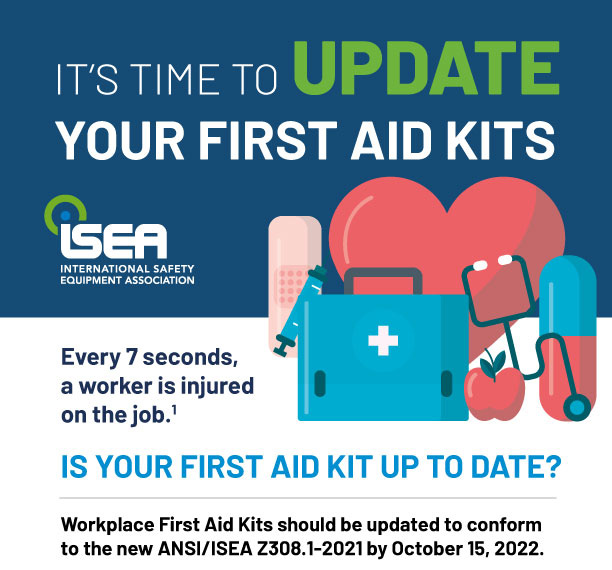Your First Aid Kit Is (Probably) Outdated!
Every construction site should update its first aid kit by October 15, 2022.
By Nicole Randall, Contributor
The old saying, “Out of sight, out of mind,” unfortunately applies to many workplace first aid kits. But there’s a good reason to pull existing kits off the wall, out of the closet, or out of the truck, and pop them open for a look before October 15, 2022.
That’s when a newly revised industry consensus standard for first aid kits takes effect. Construction site safety teams should review the contents of all their first aid kits to make sure they’re in compliance.
The new standard is titled “ANSI/ISEA Z308.1-2021, American National Standard for Minimum Requirements for Workplace First Aid Kits and Supplies.”
Last Update Was 2015
ANSI/ISEA Z308.1-2021 was developed by the International Safety Equipment Association (ISEA) First Aid Product Group, and approved by key stakeholders representing construction groups, technology corporations, testing laboratories, utility companies, and others. The standard was processed and approved using consensus procedures prescribed by the American National Standards Institute (ANSI).
This is the sixth update since the standard was first published in 1978. The last update prior to this was in 2015. Certain elements of the 2015 update were retained for 2022.
In particular, the new standard kept the kit classification established in 2015 — Class A and Class B — which is based on workplace environment.
- Class A first aid kits are intended to provide a basic range of products to deal with the most common types of injuries encountered in the workplace including: major wounds, minor wounds (cuts and abrasions), minor burns, and eye injuries.
- Class B kits are intended to provide a broader range and quantity of supplies to deal with injuries encountered in more populated, complex, and/or high-risk workplace environments.
The new standard also details how first aid kits should be marked and labeled, what supplies they should contain, and provides specifications for certain supplies.
Notable changes in kit contents include:
- Foil blankets: The new standard makes a foil blanket mandatory for every first aid kit. The requirement reflects international standards and was added because foil blankets can serve multiple purposes, such as treating hypothermia, acting as a windbreaker, and serving as an emergency waterproof wrap.
- Specs: The foil blanket shall be a metalized plastic sheet, having a minimum size of 52 x84 in (132 x 213 cm) and shall be single use.
- Tourniquets: The revised standard clarifies types of tourniquets, helping differentiate them from bands used to draw blood (which aren’t as effective at preventing blood loss).
- Specs: Each tourniquet shall be at least 1.5 in. (3.8 cm) wide and shall be effective on limb sizes ranging from 7 to 33 in (17.8 to 83.8 cm). Each tourniquet shall be individually packaged as a single-use device, with instructions.
- Bleeding control kits: The 2022 standard offers more guidance on designated bleeding control kits, which contain more advanced first aid supplies to immediately treat life-threatening external bleeding.
- Guidance: Essential bleed control items include chest seal, compression bandage, hemostatic bandages, thermal blanket, and tourniquet.
First Aid Kit Types
ANSI/ISEA Z308.1-2021 outlines intended uses and specs for four types of first aid kit containers. (Note that Type IV is anticipated for the construction industry.)
- Type I first aid kits are intended for use in stationary, indoor settings where the potential for damage of kit supplies due to environmental factors and rough handling is minimal. Type I kits shall have a means for mounting in a fixed position and are generally not intended to be portable.
- Typical applications for Type I kits may include, but are not limited to, general indoor use, an office setting, or a manufacturing facility. First aid cabinets would generally fall into the Type I classification.
- Type II first aid kits are intended for portable use in indoor settings where the potential for damage of kit supplies due to environmental factors and rough handling is minimal.
- Typical applications for Type II kits may include, but are not limited to, general indoor use, an office setting, or a manufacturing facility.
- Type III first aid kits are intended for portable use in mobile, indoor, and/or outdoor settings where the potential for damage of kit supplies due to environmental factors is not probable. Type III kits shall have a means to be mounted in a fixed position and shall have a water-resistant seal.
- Typical applications for Type III kits may include general indoor use and sheltered outdoor use.
- Type IV first aid kits are intended for portable use in the mobile industries and/or outdoor settings where the potential for damage to kit supplies due to environmental factors and rough handling is significant. Type IV kits shall have a means to be mounted in a fixed position and shall meet the performance requirements of Section 5.2.5.
- Typical applications for Type IV kits may include, but are not limited to, the transportation industry, the utility industry, the construction industry, and the armed forces.
Since kit visibility and identification is crucial, the standard specifies that all labeling and markings shall be legible and permanent. Where adhesive labels are used, they shall not be easily removed. Each kit and/or location shall be visibly marked as a place where first aid supplies are located. The standard also illustrates the information each complete first aid kit shall contain (shown in ANSI/ISEA Z308.1-2021 as Figure 1A or Figure 1B).
Take a Fresh Look at Your Hazards
Each construction site poses its own risks, so every first aid kit needs to reflect the particular hazards and potential incidents at that site. The new standard helps employers assess risks, identify potential hazards, and select additional first aid supplies that are relevant to a particular application or work environment.
“Employers should conduct a thorough workplace hazard assessment to help them determine which supplies to augment,” says Todd VanHouten, director of product development and innovation at Cintas First Aid & Safety, and chair of ISEA’s First Aid Product Group.
VanHouten says the new standard is a timely reminder to update first aid stations, kits and protocols. Those tasks might seem like nice-to-do’s compared to the many must-do’s on a busy construction manager’s priority list. And human nature leans toward “it won’t happen here” thinking. But private industry employers in the U.S. reported 2.7 million workplace nonfatal injuries and illnesses in 2020, according to the U.S. Bureau of Labor Statistics (BLS).
So, staying up to date is more than just a compliance issue. Being prepared is the smart thing to do.
“The discussions and recommendations in this standard can help guide an organization’s overall first aid program, ultimately helping to provide proper and timely treatment for all employees,” adds VanHouten.
Resources Available
ISEA and its First Aid Product Group produced a free webinar to help employers learn about the updated standard and what’s needed to be Z308.1 compliant. A live presentation was held back in May, but a free recording of the webinar, along with other free resources, is available on ISEA’s website at: safetyequipment.org/firstaid.
The webinar features recognized leaders in the research and development of first aid treatment items and training, including representatives from Acme United, Certified Safety, Cintas Corporation, and Medique Products.
The standard itself is available for $65 directly from ISEA or through licensed resellers.
Nicole Randall is the director of marketing and external affairs for the International Safety Equipment Association (https://safetyequipment.org) in Arlington, Virginia, which is the trade association in the U.S. for personal protective equipment, products, and technologies. Its member companies are world leaders in the design, manufacture, testing and distribution of protective clothing and equipment used to protect more than 100 million American workers at construction sites, in factories, hospitals and clinics, farms, schools, laboratories, emergency response and in the home. Since 1933, ISEA has set the standard for the personal protective equipment industry, supporting member companies united in the goal of protecting the health and safety of people worldwide.
Share on Socials!
How to Properly Care for Rubber Insulating Gloves, Sleeves, and Blankets to Extend Use and Safety
PPE: Electrical Safety in the Workplace
Arc Flash Safety: Helping Companies Keep Workers Protected from one of the Most Dangerous Electrical Safety Hazards
Leaders in Electrical Safety
• Aramark
• Bowtie Engineering
• Enespro
• Ericson
• I-Gard Corporation
• IRISS
• KERMEL, INC.
• Lakeland Industries
• MELTRIC Corporation
• National Safety Apparel
• National Technology Transfer
• Oberon
• Saf-T-Gard
• SEAM Group
Subscribe!
Sign up to receive our industry publications for FREE!









